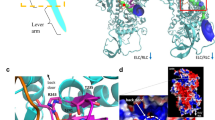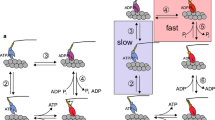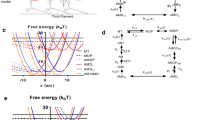Abstract
The loss of muscle force and power during fatigue from intense contractile activity is associated with, and likely caused by, elevated levels of phosphate (\(\mathrm {P}_{\mathrm{i}}\)) and hydrogen ions (decreased pH). To understand how these deficits in muscle performance occur at the molecular level, we used direct measurements of mini-ensembles of myosin generating force in the laser trap assay at pH 7.4 and 6.5. The data are consistent with a mechanochemical model in which a decrease in pH reduces myosin’s detachment from actin (by slowing ADP release), increases non-productive myosin binding (by detached myosin rebinding without a powerstroke), and reduces myosin’s attachment to actin (by slowing the weak-to-strong binding transition). Additional support of this mechanism is found by incorporating it into a branched pathway model for the effects of \(\mathrm {P}_{\mathrm{i}}\) on myosin’s interaction with actin. Including pH-dependence in one additional parameter (acceleration of \(\mathrm {P}_{\mathrm{i}}\)-induced detachment), the model reproduces experimental measurements at high and low pH, and variable \(\mathrm {P}_{\mathrm{i}}\), from the single molecule to large ensemble levels. Furthermore, when scaled up, the model predicts force-velocity relationships that are consistent with muscle fiber measurements. The model suggests that reducing pH has two opposing effects, a decrease in attachment favoring a decrease in muscle force and a decrease in detachment favoring an increase in muscle force. Depending on experimental details, the addition of \(\mathrm {P}_{\mathrm{i}}\) can strengthen one or the other effect, resulting in either synergistic or antagonistic effects. This detailed molecular description suggests a molecular basis for contractile failure during muscle fatigue.






Similar content being viewed by others
References
Allen DG, Lamb GD, Westerblad H (2008) Skeletal muscle fatigue: cellular mechanisms. Physiol Rev 88:287–332
Allen D, Westerblad H (2004) Lactic acid—the latest performance-enhancing drug. Science 305:1112–1113
Baker JE, Brosseau C, Joel PB, Warshaw DM (2002) The biochemical kinetics underlying actin movement generated by one and many skeletal muscle myosin molecules. Biophys J 82:2134–2147
Bell GI (1978) Models for the specific adhesion of cells to cells. Science 200:618–627
Bottinelli R, Canepari M, Pellegrino MA, Reggiani C (1996) Force-velocity properties of human skeletal muscle fibres: myosin heavy chain isoform and temperature dependence. J Physiol 495:573–586
Bowater R, Sleep J (1988) Demembranated muscle fibers catalyze a more rapid exchange between phosphate and adenosine triphosphate than actomyosin subfragment 1. Biochemistry 27:5314–5323
Cady EB, Jones DA, Lynn J, Newham DJ (1989) Changes in force and intracellular metabolites during fatigue of human skeletal muscle. J Physiol 418:311–325
Campbell KS (2009) Interactions between connected half-sarcomeres produce emergent mechanical behavior in a mathematical model of muscle. PLoS Comput Biol 5:e1000560
Campbell KS (2016) Compliance accelerates relaxation in muscle by allowing myosin heads to move relative to actin. Biophys J 110:661–668
Capitanio M, Canepari M, Cacciafesta P, Lombardi V, Cicchi R, Maffei M, Pavone FS, Bottinelli R (2006) Two independent mechanical events in the interaction cycle of skeletal muscle myosin with actin. Proc Natl Acad Sci 103:87–92
Chase PB, Kushmerick MJ (1988) Effects of pH on contraction of rabbit fast and slow skeletal muscle fibers. Biophys J 53:935–946
Cooke R, Franks K, Luciani GB, Pate E (1988) The inhibition of rabbit skeletal muscle contraction by hydrogen ions and phosphate. J Physiol 395:77–97
Cooke R, Pate E (1985) The effects of ADP and phosphate on the contraction of muscle fibers. Biophys J 48:789–798
Debold EP (2012) Recent insights into muscle fatigue at the cross-bridge level. Front Physiol 3:151
Debold EP, Beck SE, Warshaw DM (2008) Effect of low pH on single skeletal muscle myosin mechanics and kinetics. Am J Physiol 295:C173–C179
Debold EP, Dave H, Fitts RH (2004) Fiber type and temperature dependence of inorganic phosphate: implications for fatigue. Am J Physiol 287:C673–C681
Debold EP, Fitts RH, Sundberg C, Nosek TM (2016) Muscle fatigue from the perspective of a single crossbridge. Med Sci Sports Exerc 48:2270–2280
Debold EP, Longyear TJ, Turner MA (2012) The effects of phosphate and acidosis on regulated thin-filament velocity in an in vitro motility assay. J Appl Physiol 113:1413–1422
Debold EP, Patlak JB, Warshaw DM (2005) Slip sliding away: load-dependence of velocity generated by skeletal muscle myosin molecules in the laser trap. Biophys J 89:L34–L36
Debold EP, Turner MA, Stout JC, Walcott S (2011) Phosphate enhances myosin-powered actin filament velocity under acidic conditions in a motility assay. Am J Physiol 300:R1401–R1408
Debold EP, Walcott S, Woodward M, Turner MA (2013) Direct observation of phosphate inhibiting the force-generating capacity of a miniensemble of myosin molecules. Biophys J 105:2374–2384
De La Cruz EM, Wells AL, Sweeney HL, Ostap ME (2000) Actin and light chain isoform dependence of myosin V kinetics. Biochemistry 39:14196–14202
Fitts RH (1994) Cellular mechanisms of muscle fatigue. Physiol Rev 74:49–94
Fitts RH (2016) The role of acidosis in fatigue: pro perspective. Med Sci Sports Exerc 48:2335–2338
Harris DE, Warshaw DM (1993) Smooth and skeletal muscle myosin both exhibit low duty cycles at zero load in vitro. J Biol Chem 268:14764–14768
Hibberd MG, Dantzig JA, Trentham DR, Goldman YE (1985) Phosphate release and force generation in skeletal muscle fibers. Science 228:1317–1319
Homsher E, Wang F, Sellers JR (1992) Factors affecting movement of F-actin filaments propelled by skeletal muscle heavy meromyosin. Am J Physiol 262:C714–C723
Kad NM, Patlak JB, Fagnant PM, Trybus KM, Warshaw DM (2007) Mutation of a conserved glycine in the SH1-SH2 helix affects the load-dependent kinetics of myosin. Biophys J 92:1623–1631
Karatzaferi C, Adamek N, Geeves MA (2017) Modulators of actin-myosin dissociation: basis for muscle type functional differences during fatigue. Am J Physiol 313:C644–C654
Karatzaferi C, Franks-Skiba K, Cooke R (2008) The inhibition of shortening velocity of skinned skeletal muscle fibers in conditions that mimic fatigue. Am J Physiol 294:R948–R955
Knuth ST, Dave H, Peters JR, Fitts RH (2006) Low cell pH depresses peak power in rat skeletal muscle fibres at both \(30^{\circ }\)C and \(15^{\circ }\)C: implications for muscle fatigue. J Physiol 575:887–899
Kovács M, Tóth J, Hetényi C, Málnási-Csizmadia A, Sellers JR (2004) Mechanism of blebbistatin inhibition of myosin II. J Biol Chem 279:35557–35563
Lamb GD, Stephenson DG, Bangsbo J, Juel C (2006) Point:counterpoint: lactic acid accumulation is an advantage/disadvantage during muscle activity. J Appl Physiol 100:1410–1412
Linari M, Caremani M, Lombardi V (2010) A kinetic model that explains the effect of inorganic phosphate on the mechanics and energetics of isometric contraction of fast skeletal muscle. Proc R Soc B Biol Sci 277:19–27
Llinas P, Isabet T, Song L, Ropars V, Zong B, Benisty H, Sirigu S, Morris C, Kikuti C, Safer D, Sweeney HL, Houdusse H (2015) How actin initiates the motor activity of myosin. Dev Cell 33:401–412
Longyear T, Walcott S, Debold EP (2017) The molecular basis of thin filament activation: from single molecule to muscle. Sci Rep 7:1822
Lymn RW, Taylor EW (1971) Mechanism of adenosine triphosphate hydrolysis by actomyosin. Biochemistry 10:4617–4624
Margossian SS, Lowey S (1982) Preparation of myosin and its subfragments from rabbit skeletal muscle. Methods Enzymol 85:55–71
Mijailovich SM, Kayser-Herold O, Stojanovic B, Nedic D, Irving TC, Geeves MA (2016) Three-dimensional stochastic model of actin-myosin binding in the sarcomere lattice. J Gen Physiol 148:459–488
Muretta J, Rohde JA, Johnsrud DO, Cornea S, Thomas DD (2015) Direct real-time detection of the structural and biochemical events in the myosin power stroke. Proc Natl Acad Sci 112:14272–14277
Nelson CR, Debold EP, Fitts RH (2014) Phosphate and acidosis act synergistically to depress peak power in rat muscle fibers. Am J Physiol 307:C939–C950
Nosek TM, Fender KY, Godt RE (1987) It is diprotonated inorganic phosphate that depresses force in skinned skeletal muscle fibers. Science 10:191–193
Pastra-Landis SC, Huiatt T, Lowey S (1983) Assembly and kinetic properties of myosin light chain isozymes from fast skeletal muscle. J Mol Biol 170:403–422
Pate E, Bhimani M, Franks-Skilba K, Cooke R (1995) Reduced effect of pH on skinned rabbit psoas muscle mechanics at high temperatures: implications for fatigue. J Physiol 486:689–694
Pate E, Cooke R (1989) A model of crossbridge action: the effects of ATP, ADP and \(\rm P_{{\rm i}}\). J Musc Res Cell Motil 10:181–196
Pederson TH, Nielson OB, Lamb GD, Stephenson DG (2004) Intracellular acidosis enhances the excitability of working muscle. Science 305:1144–1147
Potma EJ, vanGraas IA, Stienen GJ (1995) Influence of inorganic phosphate and pH on ATP utilization in fast and slow skeletal muscle fibers. Biophys J 69:2580–2589
Previs MJ, Previs SB, Gulick J, Robbins J, Warshaw DM (2012) Molecular mechanics of cardiac myosin-binding protein C in native thick filaments. Science 337:1215–1218
Robergs RA, Ghiasvand F, Parker D (2004) Biochemistry of exercise-induced metabolic acidosis. Am J Physiol 287:R502–R516
Siemankowski RF, Wiseman WO, White HD (1985) ADP dissociation from actomyosin subfragment 1 is sufficiently slow to limit the unloaded shortening velocity in vertebrate muscle. Proc Natl Acad Sci 82:658–662
Smith DA (2014) A new mechanochemical model for muscle, where force and movement are triggered by phosphate release. J Musc Res Cell Motil 35:295–306
Spudich JA, Watt S (1971) The regulation of rabbit skeletal muscle contraction. I. Biochemical studies of the interaction of the tropomyosin-troponin complex with actin and the proteolytic fragments of myosin. J Biol Chem 246:4866–4871
Stoecker U, Telley IA, Stüssi E, Denoth J (2009) A multisegmental cross-bridge kinetics model of the myofibril. J Theor Biol 259:714–726
Tanner BCW, Daniel TL, Regnier M (2007) Sarcomere lattice geometry influences cooperative myosin binding in muscle. PLoS Comput Biol 3:e115
Tanner BCW, Daniel TL, Regnier M (2012) Filament compliance influences cooperative activation of thin filaments and the dynamics of force production in skeletal muscle. PLoS Comput Biol 8:e1002506
Tyska MJ, Depuis DE, Guilford WH, Patlak JB, Waller GS, Trybus KM, Warshaw DM, Lowey S (1999) Two heads of myosin are better than one for generating force and motion. Proc Natl Acad Sci 96:4402–4407
Uyeda TQP, Kron SJ, Spudich JA (1990) Myosin step size: estimation from slow sliding movement of actin over low densities of heavy meromyosin. J Mol Biol 214:699–710
Veigel C, Molloy JE, Schmitz S, Kendrick-Jones J (2003) Load-dependent kinetics of force production by smooth muscle myosin measured with optical tweezers. Nat Cell Bio 5:980–986
Walcott S, Sun SX (2009) Hysteresis in cross-bridge models of muscle. Phys Chem Chem Phys 11:4871–4881
Walcott S, Warshaw DM, Debold EP (2012) Mechanical coupling between myosin molecules causes differences between ensemble and single-molecule measurements. Biophys J 103:501–510
Webb MR, Hibberd MG, Goldman YE, Trentham DR (1986) Oxygen exchange between Pi in the medium and water during ATP hydrolysis mediated by skinned fibers from rabbit skeletal muscle. Evidence for Pi binding to a force-generating state. J Biol Chem 261:15557–15564
Westerblad H (2016) Acidosis is not a significant cause of skeletal muscle fatigue. Med Sci Sports Exerc 48:2339–2342
Westerblad H, Bruton JD, Lännergren J (1997) The effect of intracellular pH on contractile function of intact, single fibres of mouse muscle declines with increasing temperature. J Physiol 500:193–204
White HD, Taylor EW (1976) Energetics and mechanism of actomyosin adenosine trophosphatase. Biochemistry 15:5818–5826
Widrick JJ, Trappe SW, Costill DL, Fitts RH (1996) Force-velocity and force-power properties of single muscle fibers from elite master runners and sedentary men. Am J Physiol 271:C676–C683
Wilson JR, McCully KK, Mancini DM, Boden B, Chance B (1988) Relationship of muscular fatigue to pH and diprotonated \(\text{ P }_{{\rm i}}\) in humans: a \({}^{31}\)P-NMR study. J Appl Physiol 64:2333–2339
Woodward M, Debold EP (2018) Acidosis and phosphate directly reduce myosin’s force-generating capacity through distinct molecular mechanisms. Front Physiol 9:862
Funding
This work was funded by the National Science Foundation (DMS-1413185).
Author information
Authors and Affiliations
Corresponding author
Additional information
This work is supported, in part, by NSF DMS-1413185 to SW.
Electronic supplementary material
Below is the link to the electronic supplementary material.
Rights and permissions
About this article
Cite this article
Jarvis, K., Woodward, M., Debold, E.P. et al. Acidosis affects muscle contraction by slowing the rates myosin attaches to and detaches from actin. J Muscle Res Cell Motil 39, 135–147 (2018). https://doi.org/10.1007/s10974-018-9499-7
Received:
Accepted:
Published:
Issue Date:
DOI: https://doi.org/10.1007/s10974-018-9499-7




